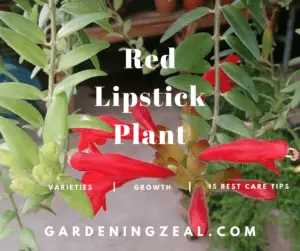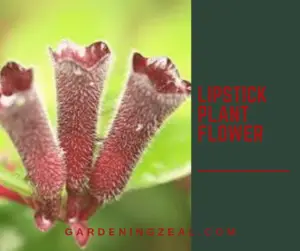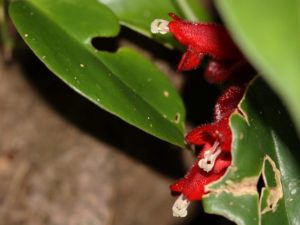Turing your hectic days and gloomy nights into splashy colors of life is the duty of FLOWERING PLANTS. In the catalog of flowering plants, LIPSTICK PLANT is not less than any plant showcasing its charms.
Lipstick plant is a beautiful flowering plant with unusual lipstick like red flowers beautifully grown on glossy green leaves.
It is a tropical plant with a warm and humid-loving climate.
You can easily grow and take care of this amazing plant by following this care guide as 15 best exceptionally working tips are waiting for you.
Key Learning Points
Lipstick Plant Scientific Name
The scientific name of this amazing plant is ‘Aeschynanthus radicans’ while its common name ”lipstick vine” is also popular among people.
What is Lipstick Plant – Key Characteristics
Lipstick plant (Aeschynanthus radicans), a member of the Gesneriaceae family is an unusual flowering plant with shiny, waxy foliage and showy flowers that bloom all the year.
It is an outstanding indoor plant that can easily grow and beautify your lounge or simply adds color to the dining room.
Conspicuous lipstick plant is also called lipstick vine as is the native to temperate regions where it grows as trailing vines along with substantial trees.
The plant gets its name lipstick plant as flower buds protrude from tubes resembling lipstick tubes. Bright red blossoms (just like your favorite red lipstick) emerging from dark maroon tubes, manifest multiple lipsticks hanging over the vine.
Lipstick Plant Varieties – Each with Unique Characteristics
The lipstick plant gives you a wide range of varieties to grow in your indoors. Exotic angle plants give 400 plant species including wide varieties.
You can easily plant and care any of the following varieties
-
Cassiopeia Lipstick Plant
An outstanding plant with bright red flowers emerging from dark purple red buds.
-
Curly Q Lipstick Plant
It has curly dark green leaves as the name indicates. These leaves curl and twist giving an unusual appearance to the plant.
-
Krakau Lipstick Plant
Most widely grown lipstick plant with shiny, pointed dark green leaves and countless red flowers.
-
Mini Variegated
Unique characteristics associated with it are medium green leaves with small reddish flowers.
-
Purple Star Plant
Lush bright green leaves with red flowers are unique specialties of the purple star lipstick plants.
-
Red Lipstick Plant
It has red flowers and shiny bright green leaves like purple star.

-
Tangerine Lipstick Plant
Orange-yellow flowers with green leaves are the main unique characteristics of the tangerine variety.
-
Variegated Variety
It is a variety with the most unique and diversified features. It has white streaking leaves and orange-red flowers.
All of the above-mentioned varieties are worth growing and have their own specific characteristics but there are bonus varieties that must be irreplaceable from your lounge
- Black Pagoda
- Mona Lisa
- Rasta Lipstick Plant
Lipstick Plant Black Pagoda
Pagoda Lipstick Plant (Aeschynanthus radicans) blooms beautiful yellow flowers and variegated leaves that is why this variety of lipstick plants is of prime interest.
You can easily grow it by placing it in indirect bright light under regular watering and humid environment at 65-850C.
Height: 12 in.
Spread: 10 – 25 inches
Flowering Time: Late spring to early summer
There are more or fewer similarities in lipstick plants and columneas but not to be confused.
You can easily differentiate between these two. Both produce beautiful blooms but are more prominent produced on columnea than on Aeschynanthus.
Lipstick Plant Mona Lisa
Aeschynanthus pulcher ‘Mona Lisa’ blooms Orange-red flower and displays dark green leaves on it. It is beautiful indoor greenery that you can hang in decorative pots to freshen your indoors.
- Like other lipstick plants, Aeschynanthus pulcher ‘Mona Lisa’ also likes bright indirect light. South or west-facing windows are the best places near indoor windowsills.
- Temperature ranging from 17-20 0C is ideal for its growth. It can also tolerate under 100.
- Do not overwater Mona Lisa Plant as it requires moist, not soggy soil. Try to give it a humid environment.
- You can also put it in the washroom or kitchen.
- Balanced liquid fertilizer would be needed to feed it. Fertilize it every month during its growth time i.e, spring and summer.
- Height: 40 cm
- Feeding: Balanced, after three weeks approximately
Lipstick Plant Rasta
Aeschynanthus radicans Rasta, the beautiful houseplant with curly green leaves and abundant red flowers peeking out of maroon calyx, is the best option for your indoor plant catalog.
Curly leaves beautifully covering flowers add a splendid soothing feeling to your lounge.
‘Rasta’ does not need pampered conditions for growth. It is easy to grow plants requiring bright light but can thrive low light as well.
Best blooming occurs in late summer or early fall presenting plant a cascade of protruding lipsticks over the vine.
Height: 10-25
Light requirement: partial sun to shade
How to Grow Lipstick Plant Aeschynanthus – Growth Requirements
Growing this plant is a not difficult task. If you are a beginner or an expert gardener you can easily grow and maintain it by reading this article.
Detailed best caring tips of this plant are also discussed after elaborating growth requirements. Keep reading for the best understanding of all aspects.
Here we discuss all growth requirements of this stunning plant.
1. Location – Best Place for Aeschynanthus
The first and foremost step to grow any plant is to decide its suitable place. If you have planted seeds for any plant without considering its location and waiting for blooms, you are not going to get the fruit for your efforts.
Decide location first, grow plants later on.

As the lipstick plant is native to Malaysia, it grows best in warm and moist conditions. Basically, it is an indoor plant and requires a damp and shady place where it feels more comfortable.
You can place your pot on the porch, lounge, or on a balcony not facing direct sunlight. Hanging decorative pots in rooms or offices with under saucers are best for vines.
2. Lipstick Plant Soil Requirement
Lipstick houseplant does not require a special type of soil. Balanced, aerated and light soil with proper drainage is needed as light soil to do not retain water and is easy to drain.
- You can also use potting mix specially designed for houseplants but most of them need a light substance for proper growth as the potting mix will be heavy.
- If you want the best growth, the most advisable is to prepare your own potting mix by taking potting soil, potting mix, and peat in equal proportions.
- Compost, peat, and potting mix in equal proportions also give the best potting soil.
3. Watering
Watering a plant at a time adds to its life. Make your principle not to overwater plants especially indoors. The same is the case with lipstick houseplants.
It does not require much watering. Check the plant before giving water. If the top quarter of the soil is dried, it is time to water it.
It will give the best blooms.
- Spring to summer is the time of growth, so be careful during the growing season because the plant does not need much water at the growth phase or dormancy period.
- Water once a week from spring to summer.
- Fall to winter is the colder time and growth slows down. You need to give less water.
- Once in 2-3 weeks is most appropriate in winters.
4. Humidity
Lipstick plants like humidity as they are native to a humid environment. Keep them moist by spraying on a regular basis or place them in a moist area of your house.
They won’t survive in dry air.
5. Lipstick Plant Light Requirement
Bright indirect light is ideal for the best growth of lipstick houseplant. If it is not blooming, change its place in brighter light.
It will give you blooms.
Direct sunlight can burn leaves which results in drooping of leaves.
6. Temperature
Lipstick plant is native to tropical region, therefore, survives in warm conditions.
- It gives ideal flowering when the temperature ranges from 70-800F (22-280 C).
- Can tolerate below 600F but shows fewer blooms.
- Most of the damage is caused when the temperature drops down below 500F (100C) as it is not clod tolerant.
You can also assess temperature fluctuations by seeing getting dark red leaves that show internal damage to plants.
7. Fertilizer
Use organic fertilizers for indoor houseplants as they cause less or no harm as compared to other fertilizers.
- General-purpose liquid fertilizer or compost fertilizer is the best option to use.
- If you are using slow-release fertilizer in potting soil, you can skip further fertilization for up to 3 months.
- After that fertilize once every three-week during the growth phase from spring to summer.
- No need to add fertilizer in winters.
- Adding a small number of vitamins with fertilizers also gives good results.
8. Pinching
Pinching the tips of branches gives good dense growth.
Lipstick Plant Care – 15 Best Exceptionally Working Tips for Blooms
- Prune with care. Use sharp pruning shears and prune at a leaf node.
- The best reporting time is spring or summer. Repot just one pot size above. It will give the best blooming.
- Giving plants some rest in winters will give you good results in spring and summer. Avoid fertilizing in this resting time.
- Use a room humidifier to moisten the air as indoor hanging plants are closer to the ceiling and get warmth from the roof and walls.
- Aphids, insects, and bugs are attracted to lipstick houseplants. Use neem oil to prevent the plant from pests.
- Not overwater plant as it causes fungal attack producing black spots on leaves and stem. These spots lessen its beauty so, keep it moist but overwatered.
- If the plant is attacked by fungus, use fungicide at right time before its spread.
- Do not repot plant after a short time of growth. The best time to repot for dense blooms is 3-4 years.
- Place the plant in a humidified area. You can place it in the bathroom or kitchen.
- Do not place the lipstick plant near air condition vents as exhaust will damage it.
- If the leaves are falling off or getting yellow, consider your watering schedule or light requirements.
- If your houseplant is facing the problem of browning of leaf edges, chances are it is facing direct sunlight or too little water.
- Growing lipstick plant in a small pot or container gives more blooms. If you will grow in a large container, its leaves will grow densely instead of flowers.
- Fertilize the plant in spring and summer and dilute ½ of the recommended strength.
- Check its status on a weekly basis whether it is safe from pests and insects. It will give you a clear and instant indication of upcoming diseases.
Lipstick Plant Problems
Lipstick house plants often face some problems. It might be attacked by insects or some diseases. Common insects or pests that attack it are aphids, bugs, mites, and scales.
Even some other problems can also cause trouble. Here are some pests and problems that the lipstick plant faces.
These insects affect plants in different ways.
- Aphids – dark brown insects that might cause severe distortion of young plants. It may also cause stunted growth.
Control – Use some sprays to control aphids. Neem oil would be the best application.
- Bugs – mealybugs are the most common bugs in damaging lipstick plants. These are whitish masses on the lower sides of leaves or on roots. It also causes stunted growth.
Control – use insecticides to control bugs.
- Mites – are so small and damage plant in an unnoticed way until it is severely damaged. Leaves are prominent affected sites of mites causing brittle and twisted leaves.
Control – be careful about these small invading insects and spray at a time with proper insecticide.

- Scales – are feeding on leaves and stems causing the death of plants.
Control – use insecticides on plants with the care of drainage.
- Drooping leaves – are its main problems that affect its beauty.
Control – you need to observe your watering schedule. If soil is too dry, water it and if it is too wet, stop watering until soggy water dries.
Can Cats Eat Lipstick Plant – Is Lipstick Plant Poisonous to Cats?
Definitely no, the lipstick plant is not poisonous to cats, dogs, or other pets. You can easily place it indoors without being worried about your pets.
It will simply decorate your room or office or any other place you hang it. You can also keep it at your side table.
Are You Worried About Lipstick Plant Blooms?
If your lipstick plant is not blossoming it might be the result of improper light or nutrients. Move your plant to the brighter area (you can place it outdoor for some time) and observe flowering.
Too much direct sunlight can also cause disturbance in blooms. If it is facing a direct light, shift your plant to indoors or shady places.
Notice your fertilizing schedule and add vitamins to the fertilization program.
What If Your Lipstick Plant Is Losing Leaves?
Falling off leaves of lipstick plants is a much-concerned question of its growers. But it is very easy to handle it. You need to see whether you are giving water on a set schedule.
Less water will cause the stem to loop down and causes shrinkage that leads to falling off the leaves.
Reschedule your watering plan and you will see good results.
After reading the detailed guide on Lipstick Plant and finding all the instructions about this interesting plant, hopefully, you will be able to grow and maintain it at your place.
You can also grow its described varieties and try multiple ones.
Read More:
Leave a Reply